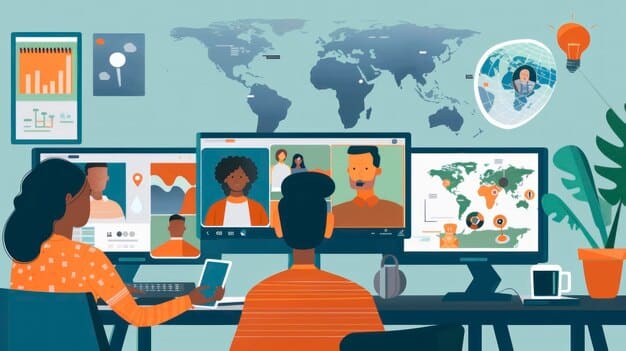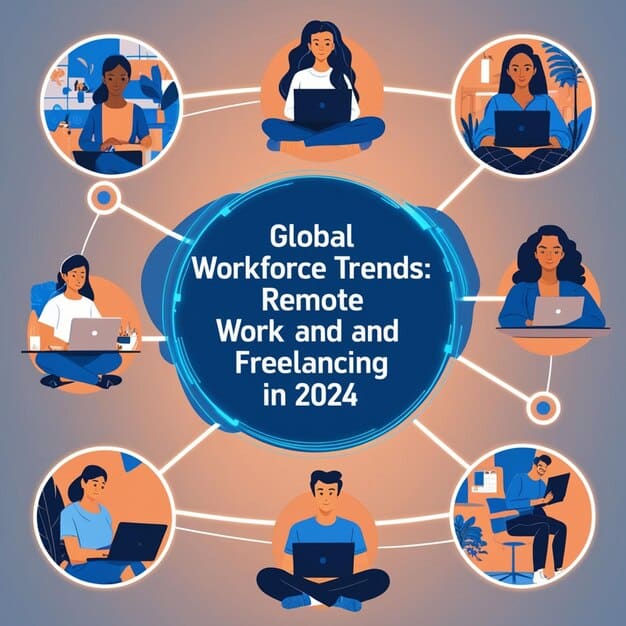Future of Work: Remote Policies Evolve by 2025 in US

By 2025, remote work policies in the US are projected to shift towards hybrid models, emphasizing flexibility, equity, and strategic integration with evolving technological and workforce demands, moving beyond pandemic-driven improvisation to structured, sustainable frameworks.
The landscape of work has undergone a seismic shift, particularly in recent years. As businesses and employees alike adapt to new paradigms, a pivotal question emerges: The Future of Work: How Will Remote Work Policies Evolve in the US by 2025? This inquiry is not merely academic; it promises to redefine corporate structures, employee expectations, and the very fabric of professional life.
The Current State of Remote Work: A Post-Pandemic Snapshot
The abrupt transition to remote work during the pandemic forced an unprecedented global experiment. Initially, it was a necessity, a stopgap measure to maintain operations. However, as the dust settled, many organizations realized its potential for increased productivity, reduced overhead, and enhanced employee satisfaction. This shift propelled remote work from a niche perk to a mainstream operational model.
Before the pandemic, remote work was primarily embraced by tech companies and a few progressive organizations. The infrastructure, both physical and digital, was largely underdeveloped for widespread adoption. Companies relied on traditional office spaces, and communication tools were often basic. However, the pandemic accelerated technological adoption, pushing cloud computing, video conferencing, and collaboration platforms to the forefront. Employers and employees quickly adapted, discovering the feasibility of conducting business outside conventional office settings. This period demonstrated that many jobs, previously considered office-bound, could be performed effectively from anywhere. It also highlighted the diverse challenges, ranging from cybersecurity concerns to maintaining team cohesion and company culture. The rapid learning curve laid the groundwork for a more thoughtful and deliberate approach to remote work policies.
While the initial phase was characterized by improvisation, companies quickly began to formalize guidelines. These early policies often focused on basic logistics: ensuring employees had the necessary equipment, establishing communication protocols, and addressing data security. However, as the remote experiment matured, more complex issues came to light, such as the impact on mental health, work-life balance, and equitable career progression for remote versus in-office employees.

Adapting to Hybrid Models
The “all-remote” dream for some companies quickly evolved into a recognition that a hybrid approach might offer the best of both worlds. This model allows for flexibility while preserving some benefits of in-person collaboration.
The hybrid model is not a one-size-fits-all solution; it manifests in various forms. Some companies adopt a “remote-first” approach where remote work is the default, with occasional in-person gatherings. Others prefer a “office-first” model, requiring employees to be in the office a set number of days per week. The core challenge for hybrid models lies in creating a cohesive employee experience that spans both physical and virtual spaces. It demands robust technological infrastructure, intentional communication strategies, and a focus on equity to prevent a two-tiered system where remote employees feel disadvantaged. Moreover, managing diverse work styles and personal preferences within a hybrid framework requires exceptional leadership and continuous feedback loops. The flexibility offered by hybrid models aims to reduce burnout and improve work-life integration. However, it also introduces complexities in managing physical office space, IT infrastructure, and ensuring all employees have equal access to opportunities and resources, regardless of their location.
- Increased employee satisfaction: Workers appreciate the autonomy and flexibility.
- Improved talent acquisition: Companies can recruit from a wider geographical pool.
- Reduced operational costs: Less need for large, expensive office spaces.
- Enhanced work-life balance: Greater control over personal schedules.
The Economic Impact and Future Outlook
The economic ripple effects of remote work are profound, impacting everything from urban planning to local economies. By 2025, these impacts will become more entrenched, shaping policy decisions at both corporate and governmental levels. The shift away from traditional office hubs is already visible in declining commercial real estate demand in some city centers, while suburban and rural areas may experience growth as remote workers seek more affordable living or a higher quality of life. This redistribution of talent and economic activity creates new opportunities and challenges for local infrastructure, public services, and small businesses. Companies, in turn, are re-evaluating their real estate portfolios, potentially divesting from large, central headquarters in favor of smaller, more collaborative hubs or entirely decentralized operations. This economic restructuring will necessitate new policy considerations regarding taxation, urban planning, and support for remote-friendly infrastructure, such as broadband internet access in rural areas.
Remote work’s influence extends to diverse sectors, from real estate to retail, shaping how cities develop and how services are delivered. As companies adapt, they are not only optimizing their internal processes but also contributing to broader economic shifts that will require governmental policies to keep pace.
Anticipated Policy Shifts by 2025: From Ad Hoc to Strategic
By 2025, US remote work policies are set to transition from reactive measures to sophisticated, strategic frameworks. This evolution will be driven by a deeper understanding of remote work’s long-term implications, coupled with advancements in technology and a sustained demand for flexibility from the workforce. The focus will shift from merely enabling remote work to optimizing it for performance, engagement, and equity.
Formalizing Hybrid Frameworks
The ambiguity surrounding hybrid models will diminish as organizations adopt more standardized approaches. Expect policies to clearly define expectations for in-office attendance, remote days, and the supporting infrastructure. These frameworks will likely be dynamic, evolving as businesses learn what works best for their specific context.
Formalizing hybrid frameworks involves codifying aspects previously left to individual team discretion. This includes establishing guidelines for required in-office days, scheduling collaborative sessions, and ensuring equitable access to leadership and resources for all employees, regardless of their primary location. Companies will need to invest in “smart office” technologies that facilitate seamless transitions between virtual and physical collaboration. Policies will also address issues like reimbursement for home office expenses, ergonomic assessments, and the provision of high-speed internet. The goal is to create a consistent, fair, and efficient experience for both remote and in-office staff, preventing inadvertent bias or a sense of detachment among remote employees. These policies will often be developed with significant input from employees, reflecting a more democratic approach to work arrangements.
- Clear communication protocols: Defining preferred channels for different types of interactions.
- Defined in-office days/weeks: Structured time for collaborative activities and team building.
- Technology and equipment standards: Ensuring all employees have necessary tools for effective work.
- Performance management adaptations: Shifting focus from hours to measurable outcomes.
Addressing Equity and Inclusion
One of the most critical areas for policy evolution will be ensuring equity and inclusion for all employees, regardless of their work location. Concerns about “proximity bias”—where in-office employees might receive preferential treatment for promotions or opportunities—will lead to policies designed to level the playing field.
Policies addressing equity and inclusion will focus on ensuring career advancement, mentorship, and development opportunities are equally accessible to remote and in-office employees. This may involve mandatory virtual participation in key meetings, virtual-first approaches to onboarding and training, and explicit guidelines for performance reviews that mitigate location-based biases. Companies will invest in tools and training to equip managers with the skills to lead diverse, distributed teams effectively, focusing on outcomes rather than presence. Furthermore, policies will need to consider the varying needs of employees, such as those with caregiving responsibilities or disabilities, ensuring remote options provide genuine flexibility and support rather than creating new barriers. This includes fostering a culture where all voices, regardless of where they are physically located, are heard and valued.
Geographic and Legal Considerations
As remote work extends across state and even international borders, companies will face complex legal, tax, and compliance challenges. Policies by 2025 will need to navigate these intricacies with greater sophistication.
The proliferation of remote work across different states and countries introduces a labyrinth of legal and tax implications. Companies will need to develop policies that account for varying state income tax laws, differing labor laws regarding working hours, overtime, and benefits, and even local employment ordinances. For those working internationally, the complexities multiply, involving visa requirements, foreign tax obligations, and compliance with local data privacy laws. By 2025, expect to see more robust internal legal frameworks and potentially new government regulations to simplify or standardize certain aspects of remote employment across jurisdictions. This necessitates a proactive approach to understanding and adhering to diverse regulatory environments to avoid legal pitfalls and ensure fair treatment of employees, regardless of their location.

Measuring Performance and Productivity
The shift from “time spent” to “results delivered” will accelerate, with policies focusing on outcomes rather than hours. This will necessitate revamped performance management systems and metrics tailored to remote and hybrid environments.
Moving towards an outcome-based performance measurement system requires a fundamental shift in management philosophy. Policies will emphasize clear goal setting, regular check-ins focused on progress and roadblocks, and objective metrics for success. This means less emphasis on “presenteeism” and more on tangible contributions. Companies will invest in project management software, data analytics, and robust feedback systems to track performance effectively without resorting to intrusive monitoring. Training for managers will be crucial, enabling them to evaluate performance based on results and provide constructive feedback in a remote context. This approach minimizes micromanagement and empowers employees with greater autonomy, fostering trust and a culture of accountability. The goal is to ensure employees demonstrate their value through actual achievements.
The Role of Technology and Infrastructure
Technology remains the backbone of successful remote work, and its evolution will continue to shape policy development. By 2025, expect policies to mandate advanced technological integration and cybersecurity protocols.
Reliable and secure technology is paramount for effective remote work. Policies will increasingly address the provision of company-issued devices, robust cybersecurity training, and access to secure, high-speed internet. The focus will be on seamless user experiences, ensuring employees can access necessary tools and collaborate effectively regardless of their physical location.
Advanced Collaboration Tools
Beyond basic video conferencing, 2025 policies will likely push for widespread adoption of immersive collaboration tools, virtual whiteboards, and augmented reality platforms to replicate in-person interactions more effectively. This will aid in fostering innovation and team cohesion for dispersed teams.
The next generation of collaboration tools will transcend simple video calls. Policies will encourage the use of platforms that incorporate virtual reality, augmented reality, and persistent digital workspaces that allow for more immersive and spontaneous interaction. These tools aim to bridge the geographical gap, making remote collaboration feel more natural and intuitive. This includes advanced project management software with integrated communication features, AI-powered meeting transcription and summarization tools, and virtual environments designed for brainstorming and creative work. Investing in these technologies will be crucial for companies looking to maintain a competitive edge and keep remote teams highly engaged and productive. The emphasis is on frictionless collaboration that mirrors in-person dynamics as closely as possible.
Cybersecurity and Data Privacy
With an expanded attack surface due to distributed workforces, cybersecurity policies will become more stringent. Expect mandated multi-factor authentication, regular security audits, and comprehensive data protection protocols as standard across organizations.
The distributed nature of remote work significantly expands an organization’s digital attack surface, making robust cybersecurity policies indispensable. By 2025, policies will likely mandate more rigorous security measures beyond basic firewalls and antivirus software. This includes strong authentication protocols like multi-factor authentication (MFA), regular security awareness training for all employees on phishing and social engineering tactics, and the mandatory use of Virtual Private Networks (VPNs) for accessing company networks. Furthermore, data privacy regulations, such as GDPR and CCPA, will continue to influence how companies handle sensitive information, requiring stricter protocols for data storage, access, and transmission, especially when employees are working from personal devices or public networks. Regular penetration testing and vulnerability assessments will become standard practice to identify and mitigate potential risks proactively. The objective is to create a secure digital environment that protects company assets and customer data.
Infrastructure Investment
Companies will increasingly invest in robust cloud infrastructure, secure network access, and centralized IT support to ensure reliable performance and connectivity for their remote workforce.
As remote work solidifies, companies will channel significant investment into their underlying technological infrastructure. This means bolstering cloud computing capabilities to ensure scalable access to applications and data, enhancing network security to protect sensitive information, and developing sophisticated centralized IT support systems capable of assisting a globally dispersed workforce. Policies will dictate standards for home internet connectivity, perhaps offering subsidies or recommendations to ensure employees have the necessary bandwidth to perform their duties efficiently. The focus is on building a resilient, high-performing digital backbone that can support complex operations and facilitate seamless collaboration, minimizing technical disruptions and maximizing employee productivity. This proactive investment ensures that technological limitations do not hinder the effectiveness of remote or hybrid work models.
Employee Well-being and Mental Health
The well-being of employees is gaining prominence, and by 2025, remote work policies will increasingly integrate mental health support, work-life balance initiatives, and flexibility to prevent burnout.
The prolonged isolation and blurring of work-life boundaries inherent in remote work have brought employee well-being and mental health to the forefront. Policies are evolving to address these critical aspects proactively.
Work-Life Integration vs. Work-Life Balance
The traditional concept of “work-life balance” is evolving into “work-life integration.” Policies will reflect this by offering flexible schedules, asynchronous communication guidelines, and encouraging boundaries between professional and personal time to prevent burnout.
Shifting from rigid “work-life balance” to more fluid “work-life integration” acknowledges that work and personal lives often intertwine. Policies supporting this shift will offer greater flexibility in working hours, allowing employees to adjust their schedules to accommodate personal commitments, such as childcare or appointments. This might include “core hours” for collaboration, with flexibility outside those times. Companies will also implement policies encouraging asynchronous communication to reduce the expectation of immediate responses, allowing employees to manage their time more effectively. Furthermore, initiatives to promote digital detoxes, discourage after-hours emails, and provide tools for time management and stress reduction will become more common, aiming to create a healthier, more sustainable work rhythm that respects individual needs while maintaining productivity. This holistic approach supports employees in navigating their lives more effectively.
Mental Health Support and Resources
Expect policies to include expanded access to mental health resources, employee assistance programs (EAPs), and initiatives promoting psychological safety and open dialogue about well-being within remote teams.
Recognizing the impact of remote work on mental health, policies will increasingly formalize robust support systems. This means expanding access to employee assistance programs (EAPs) with more comprehensive mental health services, including therapy, counseling, and stress management resources. Companies may also offer subsidized access to meditation apps or virtual well-being platforms. Crucially, policies will aim to foster a culture of psychological safety, where employees feel comfortable discussing mental health challenges without fear of stigma or reprisal. This involves training managers to recognize signs of distress, encouraging regular check-ins, and promoting open communication about the importance of mental well-being in the workplace. The goal is to build a supportive environment that prioritizes the holistic health of the workforce.
Training for Managers and Employees
Effective remote work demands new skills. Policies will likely mandate training for managers on leading distributed teams, fostering engagement, and managing performance remotely, alongside training for employees on self-management and digital etiquette.
Successful remote work necessitates a new set of capabilities for both managers and employees. Policies will likely require comprehensive training programs designed to equip managers with the specific skills needed to lead distributed teams effectively. This includes coaching on empathetic communication, fostering trust across distances, managing performance based on outcomes, and identifying and addressing issues of isolation or disengagement. Simultaneously, employees will receive training on effective self-management, digital communication etiquette, tools for virtual collaboration, and how to maintain work-life boundaries in a remote setting. This dual approach ensures that all members of the organization are well-equipped to thrive in a flexible work environment, promoting efficiency and a positive working culture. Ongoing professional development opportunities, tailored to the nuances of remote work, will also become standard practice.
Future Trends and Potential Challenges
Looking beyond 2025, several emerging trends and persistent challenges will continue to shape the evolution of remote work policies. The landscape is dynamic, demanding continuous adaptation and foresight from organizations.
The ongoing evolution of remote work will present opportunities as well as new obstacles. Companies must remain agile to leverage new technologies and address unforeseen issues.
AI and Automation Integration
The increasing integration of AI and automation into workflows will further redefine job roles, potentially making some tasks fully remote and augmenting others. Policies will need to address how these technologies impact employee responsibilities and the skills required for the future workforce.
The rapid advancement of artificial intelligence and automation will profoundly reshape the nature of work. By 2025 and beyond, AI tools will increasingly automate routine or repetitive tasks, allowing employees to focus on more complex, creative, and strategic work. Policies will need to address the ethical implications of AI deployment, data privacy concerns relating to AI-powered monitoring tools, and the retraining initiatives required to upskill or reskill employees whose roles are augmented or transformed by automation. This technological evolution could further decentralize work, making some tasks location-agnostic, while simultaneously creating new roles that require human oversight, ethical judgment, and complex problem-solving skills in collaboration with AI. Organizations will need to develop policies that guide the responsible and beneficial integration of AI into their remote and hybrid work models, ensuring it enhances human capabilities rather than displacing them without a clear transition plan.
The Rise of “Work from Anywhere” (WFA)
Beyond national remote work, “Work from Anywhere” (WFA), where employees work from different countries, will gain traction. This presents complex challenges regarding visas, international tax laws, and compliance, necessitating new, globally-minded policies.
The concept of “Work from Anywhere” (WFA) takes remote work to an international level, allowing employees to reside and work from different countries. While offering unprecedented flexibility and access to global talent pools, WFA introduces significant policy complexities. These include navigating diverse immigration laws and visa requirements, understanding and complying with international tax treaties and social security contributions, and adhering to labor laws that vary greatly from one country to another regarding working hours, benefits, and employee protection. Companies pursuing WFA models will need specialized legal and HR expertise to develop comprehensive policies that address these multifaceted challenges, ensuring compliance, fair compensation, and equitable treatment for employees across different jurisdictions. The goal is to create frameworks that enable global mobility without incurring undue legal or financial risks for the organization or its employees.
Addressing the Digital Divide
Despite technological advancements, the digital divide persists. Policies will need to consider how to support employees in areas with limited internet access or technological literacy, ensuring equitable participation in the remote workforce.
The digital divide, characterized by disparities in access to reliable internet and digital literacy, remains a significant challenge, especially for a widely distributed workforce. Policies by 2025 will need to explicitly address how to support employees living in areas with inadequate broadband infrastructure or those who lack the necessary digital skills. This might include providing subsidies for internet access, offering company-sponsored training programs in digital proficiency, or even exploring alternative work arrangements for roles that don’t require constant high-bandwidth connectivity. Ensuring equitable access to technology and digital resources is crucial to prevent the creation of a two-tiered workforce where some employees are disadvantaged due to factors beyond their control. Companies committed to inclusivity will prioritize policies that bridge this divide, ensuring all employees can participate fully and effectively in remote or hybrid work environments.
Conclusion
The evolution of remote work policies in the US by 2025 will be a journey from reactive necessity to strategic integration. Businesses will move beyond simply “allowing” remote work to actively designing comprehensive, equitable, and technologically advanced frameworks that support a truly flexible future. These policies will be shaped by a nuanced understanding of employee well-being, the intricate legal and economic landscape, and the continuous advancements in digital tools. The goal is to foster productive, inclusive, and sustainable work environments that empower both individuals and organizations to thrive in the decades to come.
| Key Aspect | Brief Description |
|---|---|
| 🔄 Hybrid Models | Formalized policies will define clear expectations for in-office and remote work, integrating both for optimal productivity. |
| ⚖️ Equity & Inclusion | Policies will aim to mitigate “proximity bias,” ensuring equal opportunities for all employees regardless of location. |
| 💻 Tech & Security | Advanced collaboration tools and stringent cybersecurity measures will be standard, supporting seamless remote operations. |
| 🧘♀️ Well-being Focus | Emphasis on work-life integration and robust mental health support becomes a core component of future policies. |
Frequently Asked Questions About Remote Work Policies
A hybrid remote work model combines elements of in-office work with remote work, allowing employees to split their time between the physical office and a remote location. This approach aims to leverage the benefits of both setups, promoting flexibility while maintaining opportunities for in-person collaboration and team cohesion. Specific implementations vary widely by company culture and industry needs.
To address equity, future remote work policies will focus on mitigating “proximity bias.” This includes ensuring equal access to career advancement, mentorship, and development opportunities for both remote and in-office employees. Policies will mandate strong communication protocols, outcome-based performance reviews, and manager training to lead diverse, distributed teams fairly. The goal is to prevent a two-tiered system and ensure all employees feel valued.
Technology will be central to evolving remote policies, moving beyond basic communication tools. Expect mandates for advanced collaboration platforms, immersive virtual environments, and robust cybersecurity measures. Policies will also cover investments in cloud infrastructure and centralized IT support to ensure seamless connectivity and data protection. The aim is to create efficient, secure, and engaging digital workspaces for all remote employees.
Remote work policies by 2025 will increasingly prioritize employee well-being and mental health. This involves shifting from work-life balance to work-life integration concepts, offering flexible schedules, and providing mental health support through EAPs and resources. Policies will also encourage digital boundaries and psychological safety, aiming to prevent burnout and foster a supportive environment for employees working remotely.
“Work from Anywhere” (WFA) policies face significant challenges, primarily regarding complex legal and tax implications across different countries. These include navigating international labor laws, visa requirements, varying social security contributions, and diverse tax regulations. Companies must develop robust legal and HR frameworks to ensure compliance, fair compensation, and equitable treatment for employees working globally, mitigating risks associated with international employment.
The Path Forward for Remote Work in the US
The transformation of remote work from a temporary solution to a cornerstone of modern employment is undeniable. As we approach 2025, US organizations are poised to refine their remote work policies into sophisticated, strategic instruments. This evolution underscores a profound shift in how we conceive productivity, team cohesion, and employee well-being. By embracing hybrid models, prioritizing equity, leveraging advanced technology, and focusing on mental health, companies can build resilient and adaptable workforces. The journey is continuous, demanding ongoing evaluation and courage to innovate, but the destination is a more flexible, inclusive, and ultimately more human-centric future of work.





